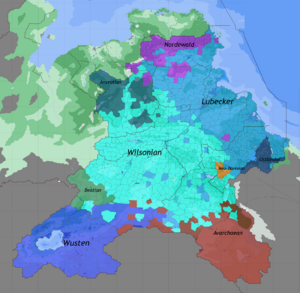Culture of the Hansa Federation
The culture of the Hansa Federation, also referred to as Hansan Culture encompasses various social behaviors, institutions, and norms in the Hansa Federation including forms of speech, literature, music, visual arts, performing arts, food, sports, religion, law, technology as well as other customs, beliefs and forms of knowledge. Hansan culture has been shaped by the history of the Hansa Federation, its geogprahy and various internal and external factors. Though Hansan culture is from Hansa there are a variety of other cultural influences such as Artevenian, Bonnic, Ethniopian, and Elianite. In more modern times Hansan culture has been influences by immigrants from every continent and immigrants from Pantsville, Dolplandia, and Tayichi. Hansans have made great strides in art and music pioneering many waves of culture historically. Notable Hansan music apcomlishments include generes such as Baroque, Jazz, Rock and Roll and many more. Major sports in Hansa include, surfing, skiing, cycling, and ice hockey. In terms of religion Hansa is reletivley even in terms of a religous split. The east is primarily Protestant, while the west and south are Pontifical. In the north the religion is primarily Elianite, but atheism has been growing since the 1960s. The cuisine of Hansa consists of many different local or regional cuisines, reflecting the nations diverse people and history and is highly regional in nature. The most commonly used and official language is Hanseatic. Distinct cultural regions include Wustiech, Appalia, Anseatia, Nordewald, Juspa, Ostland, and Veadland.
Politically, the nation takes its values from the enlightenment and the modernist movement, with an emphasis on freedom and individualism. Free speech is highly values in Hansa which is fortified by the government and the 1954 constitution. Freedom of expression is highly valued and expressed nationwide as well as the right to freely use the internet. Hansa is also extremely secular in culture stemming from the religious reformation of the sixteenth century. Hansan culture as a whol varies by factors such as region, race and ethnicity, age religion, socio-economic status, or populartion density. There is a waning class divide in Hansa as well as sub class divides the most notable being old pre Great War money and new post Great War money. Hansa exports major cultural influence on a global scale extending its influence to every continent.
Regional Variations
In the Hansa Federation each Kinderlanden has its own distinct culture however cultural geographers sometimes group them into 4 distinct regions. Northern Hansa, (Nordewald and Anseatia), Middle Hansa (Apalia, Mitteland, and sometimes Tollerland, Eastern Hansa, New Gotland, Veadland and Ostland, and Southern Hansa, (Weimeisenland, Wustiech and Tollerland. However these regions are more often then not split up into many smaller cultural regions.
Cultural Regions of the Hansa Federation
(Insert Here when decided).
Language
The official language of the Hansa Federation is Hanseatic. According to the 2020 Hanseatic Census 98% of Hansans can speak Hansan and for 86% it is the only language spoken at home. The national dialect is Wilsonian Hanseatic but Lubecker is the most populous dialect. Though Lubecker and Wilsonian are the most popular dialects there are a number of smaller dialects including but not limited to Anseatian, Nordewalder, Ostlander, Beatian and the more distinct Wusten. Though these are the major dialects specific cities have distinct accents which vary. Ethniopian is one of the most widely spoken non Hansan languages in Hansa where it is primarily spomen in the south and Ethniopian majority areas such as Morrison, Deodornt, and Wustiech.
